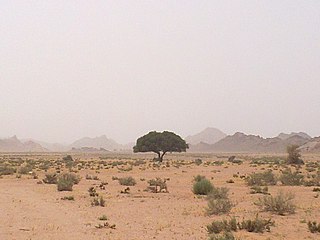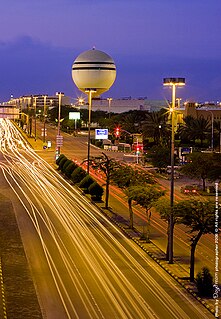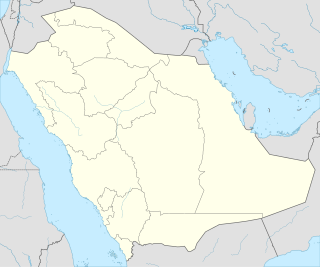
The Arabian peninsula, simplified Arabia, is a peninsula of Western Asia situated northeast of Africa on the Arabian plate. From a geographical perspective, it is considered a subcontinent of Asia.

Najd or Nejd is a geographical central region of Saudi Arabia that alone accounts for almost a third of the population of the country. Najd consists of modern administrative regions of Riyadh, Al-Qassim, and Ha'il.

Haʾil Region is a region of Saudi Arabia, located in the north of the country. It has an area of 103,887 km² and a population of 527,033 (2004) census). Its capital is Haʾil. It is subdivided into four governorates: :
- Ha'il 412,758
- Al-Ghazalah 102,588
- Ash-Shinan 41,641
- Baqa 40,157
The Rashidi dynasty, also called Al Rashid or the House of Rashid, was a historic Arabian House or dynasty that existed in the Arabian Peninsula between 1836 and 1921. Its members were rulers of the Emirate of Ha'il and the most formidable enemies of the House of Saud, rulers of the Emirate of Nejd. They were centered in Ha'il, a city in northern Nejd that derived its wealth from being on the route of the Hajj pilgrimage to Mecca, and was also a commercial center. The rulers of Ha'il were the sons of Abdullah bin Rashid, founder of the dynasty.

Buraydah is the capital of Al-Qassim Region in northcentral Saudi Arabia in the heart of the Arabian Peninsula. Buraydah lies equidistant from the Red Sea to the west and the Persian Gulf to the east. It has a population of 614,093.

Ha'il is a city in north-western Saudi Arabia. It is the capital of Ha'il Region, and has a population of about 400,000.

Al-Bahah is a city in the south west of Saudi Arabia. It is the capital of Al Bahah Region, and is one of the Kingdom's prime tourist attractions. It enjoys a pleasant climate and is surrounded by more than forty forests, including Raghdan, al Zaraeb and Baidan. Al Baha is the headquarters of the Governor, local councils and branches of governmental departments. Receiving the state's special attention, the city of Al Baha abounds in educational, tourist and health institutions. It is considered the capital of the Ghamdi and Zahrani tribes in Saudi Arabia, and most of its inhabitants are from the native tribes.

Al-Aḥsāʾ, al-Ḥasāʾ, or 'Hadjar' is a traditional oasis historical region in eastern Saudi Arabia whose name is used by the Al-Ahsa Governorate, which makes up much of that country's Eastern Province. The oasis is located about 60 km (37 mi) inland from the coast of the Persian Gulf.

Jabal Tuwaiq is a narrow escarpment that cuts through the plateau of Najd in central Arabia, running approximately 800 km (500 mi) from the southern border of Al-Qasim in the north, to the northern edge of the Empty Quarter desert near Wadi ad-Dawasir in the south. It is 600 m (2,000 ft) high and also has a Middle Jurassic stratigraphic section. The eastern side slopes downwards gradually, while the western side ends in an abrupt manner. The escarpment can be thought of as a narrow plateau, though the locals refer to it as a jebel ("mount"). Marshall Cavendish used the name "Tuwayr Mountains" to describe mountains of central Arabia, distinct from the Shammar in the north, the Dhofar in the south, and Hajar to the east.

The unification of Saudi Arabia was a military and political campaign, by which the various tribes, sheikhdoms, city-states, emirates, and kingdoms of most of the Arabian Peninsula were conquered by the House of Saud, or Al Saud, between 1902 and 1932, when the modern-day Kingdom of Saudi Arabia was proclaimed under the leadership of Ibn Saud, creating what is sometimes referred to as the Third Saudi State, to differentiate it from the Emirate of Diriyah, the First Saudi State and the Emirate of Nejd, the Second Saudi State, also House of Saud states.
Adayra Valley runs roughly from north to south, and divides the northern Saudi Arabian city of Ha'il into eastern and western halves. It starts as a branch of Rimmah Valley in the south, and drains into Qa'a Al-Milh in the town of Baq'a.

Thirteen ancient towns have been discovered in Saudi Arabia up to the present day. These include Qaryat al-Fāw, the Al-Ukhdūd archeological area, Madā'in Ṣālih, Jubbah, Tārūt, Al-Shuwayḥaṭiyah, Thāj, Taimaa and Dūmat Al-Jandal. There are still more ancient towns in Saudi Arabia, but little information is currently available on them. Saudi Arabia occupies a unique and distinctive geographic location, bridging civilizations between continents. In ancient times the Arabian peninsula served as a corridor for trade; therefore it saw the beginning of many civilizations, the relics of which are still evident today. The Saudi government has recently established the Saudi Commission for Tourism and Antiquities, which is responsible for the preservation of these cities.

Al-Hajar Mountains in northeastern Oman and also the eastern United Arab Emirates are the highest mountain range in the eastern Arabian peninsula. Also known as "Oman Mountains", they separate the low coastal plain of Oman from the high desert plateau, and lie 50–100 km (31–62 mi) inland from the Gulf of Oman.

The Emirate of Jabal Shammar, also known as the "Emirate of Haʾil" or the "Emirate of The House of Rashīd", was a state in the northern part of the Arabian Peninsula, including at Nejd, existing from the mid-nineteenth century to 1921. Jabal Shammar in English is translated as the "Mountain of the Shammar". Jabal Shammar's capital was Ha'il. It was led by a monarchy of the House of Rashīd. It included parts of modern day Saudi Arabia, Iraq and Jordan.

An izaar, also izar or ʾizār, also known as futah (فُوطَة), maʿawaz (مَعَوَز), wizarah (وِزَرَة), maqtab (مَقْطَب) is a lower garment typically worn by men in the Arabian Peninsula, notably in countries like the United Arab Emirates, Kuwait, Oman, Yemen, Bahrain, Saudi Arabia and Qatar, and the Horn of Africa. It is also worn in countries such as Indonesia, Malaysia, Bangladesh, Pakistan and countries in some parts of East Africa and in India. It is also commonly worn by some Arabs at home. In some parts of Arabia such as Yemen and the Jizan and ʿAsir regions of Saudi Arabia, it is known as futah instead. Some of these may feature tassels.

Rock Art in the Ha'il Region is the fourth site in Saudi Arabia to be inscribed on the UNESCO List of World Heritage Sites. The rock art includes two components situated in the desert of the Ha'il Region: the first is Om Sinman mountain at the city of Jubbah, and the second is al-Manjor and Raat at Al-Shuwaymis. Ancestors of today's Arab population left traces of their passings in petroglyphs on the rock's surface, holding 10,000 years of history.

The wildlife of Saudi Arabia is substantial and varied. Saudi Arabia is a very large country forming the bulk of the Arabian Peninsula. It has several geographic regions, each with a diversity of plants and animals adapted to their own particular habitats. As well as high mountains and deserts, there is a coastal plain and long coastline on the Gulf of Aqaba and the Red Sea to the west and a rather shorter coastline on the Persian Gulf to the east.
Jabal Aja Protected Area is a protected area in northern Saudi Arabia. It consists of a red granite mountain range projecting from a flatter area and is of importance for both plant and animal life. It lies at 27°30'N and 41°30'E close to the town of Ha'il and has a total area of around 200,000 hectares. Jabal Aja has been designated an Important Plant Area and an Important Bird and Biodiversity Area.

Jubbah or Jubbat Ha'il is a city in Ha'il Region, Saudi Arabia, 90 kilometres (56 mi) north-west of the city of Ha'il. The city lies on the old caravan road between Najd and the eastern Mediterranean Sea. Although completely surrounded by the vast Nefud Desert, Jubbah is known for its abundant agriculture and plentiful water and has a population of 20,000.

The Shammar Mountains is a mountain range in the northwestern Saudi Arabian province of Ha'il. It includes the Ajā and Salma subranges.















